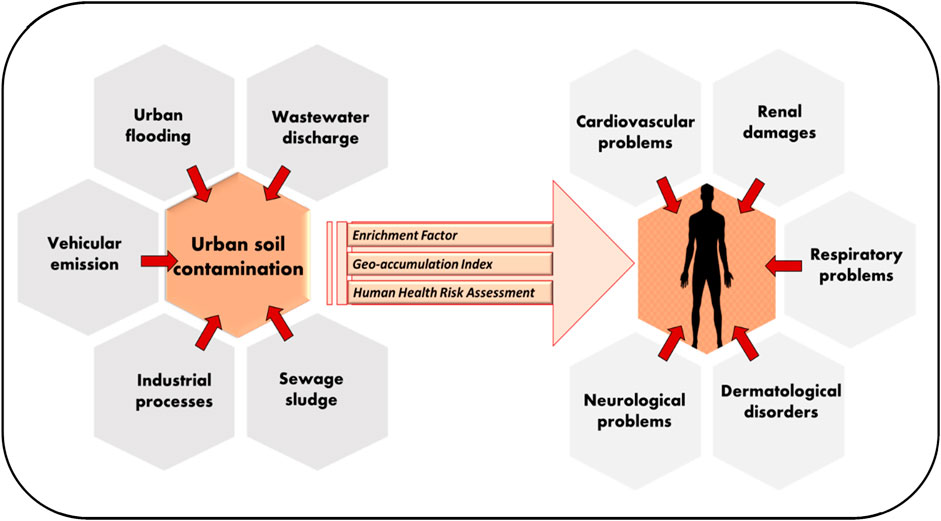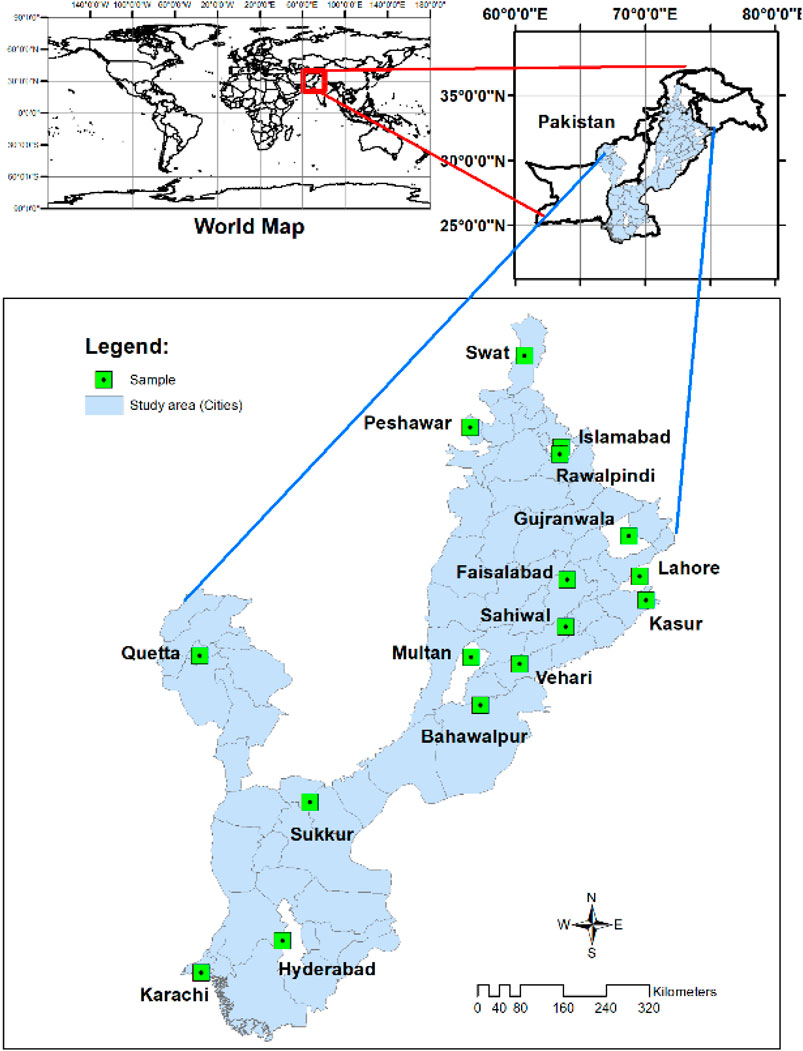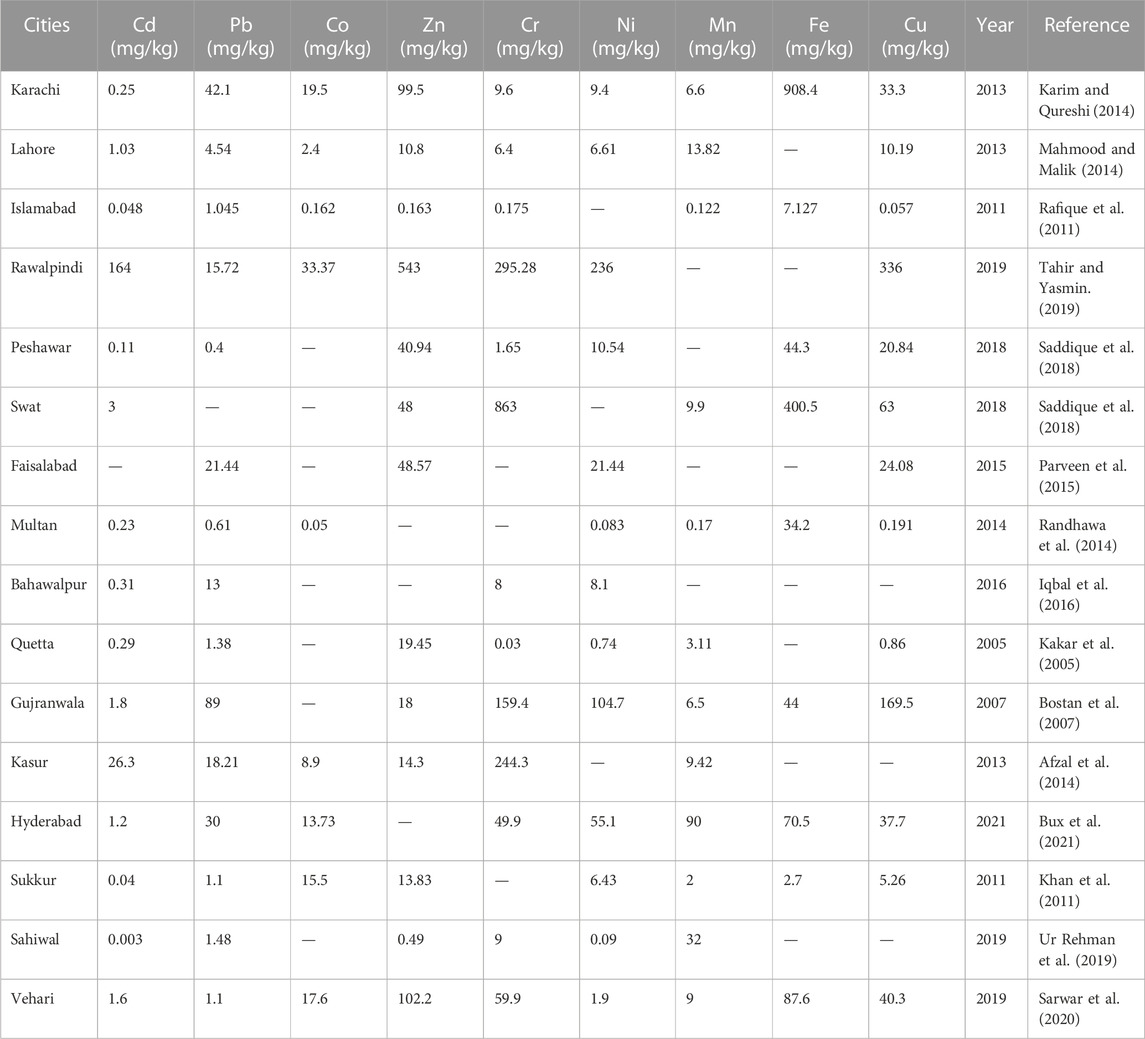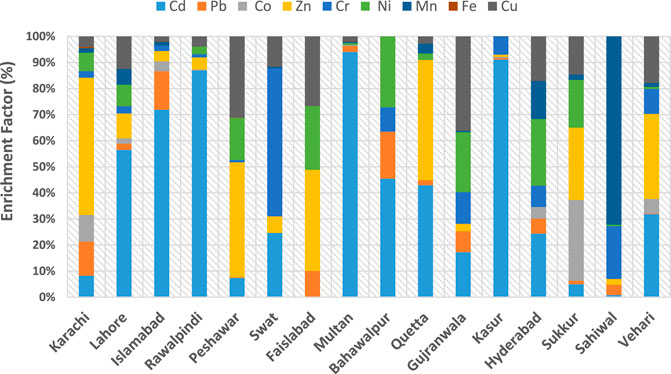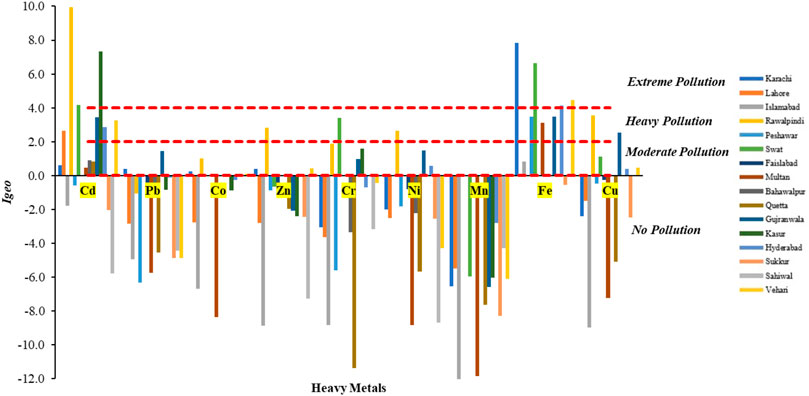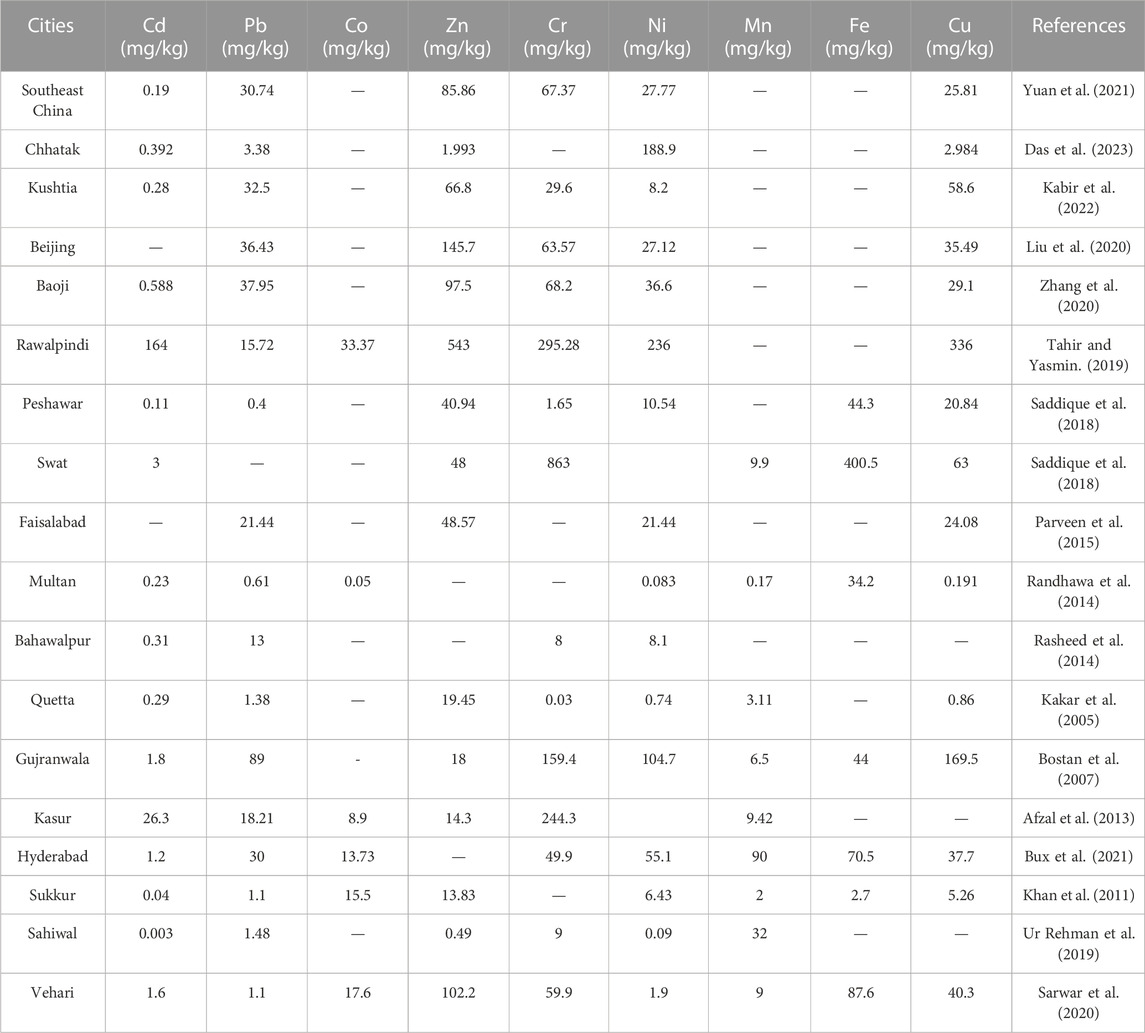- 1Department of Environmental Sciences, The University of Lahore, Lahore, Pakistan
- 2Faculty of Engineering and Quantity Surveying, INTI International University, Nilai, Negeri Sembilan, Malaysia
- 3Department of Chemistry, Government College University Faisalabad, Faisalabad, Pakistan
- 4Botany and Microbiology Department, College of Science, King Saud University, Riyadh, Saudi Arabia
- 5Department of Biology, Bahir Dar University, Bahir Dar, Ethiopia
- 6College of Resource and Civil Engineering, Northeastern University, Shenyang, China
- 7Department of Chemistry and Biochemistry, Faculty of Medicine and Pharmacy, Ibn Zohr University, Laayoune, Morocco
Introduction: This study aims to assess the extent of heavy metal contamination in urban soils in sixteen selected cities of Pakistan, encompassing the elements cadmium (Cd), lead (Pb), cobalt (Co), zinc (Zn), chromium (Cr), nickel (Ni), manganese (Mn), iron (Fe), and copper (Cu).
Methods: The data utilized for this study was collected from online literature during the period 2005 to 2019. This study investigated potential threats to human health through a comprehensive analysis, considering standards such as Enrichment Factors (EF), Geo-accumulation Indices (Igeo), and Human Health Risk Assessment (HHRA).
Results: Geo-accumulation Index results indicated varied risk intensities, with Cu, Pb, Co, Mn, and Fe exhibiting “no pollution” levels, while other elements show “moderate to extremely contaminated” values. EF analysis provided evidence of heavy metal presence, revealing a spectrum from “no pollution” to “moderate to extremely high pollution” for Cd, Zn, Cr, Ni, and Cu. The health risk assessment identified both carcinogenic and non-carcinogenic dangers for adults and children.
Discussion: These findings highlighted the substantial contribution of identified sources such as industrial processes, vehicular emissions, sewage sludge, urban flooding, and the production and use of metallic materials that have elevated heavy metal levels in the urban soils. This established the link between urban industrial zones, human health, and long-term economic sustainability. This study provides essential guidance for decision makers to develop effective strategies for soil remediation, enhanced industrial practices, and regulatory measures to address heavy metal contamination in urban areas, ensuring the wellbeing and sustainable environmental quality management in cities.
1 Introduction
The rapid urbanization and industrial growth in and around urban areas are inherently linked to the accumulation and contamination of heavy metals in the urban soil. These phenomena have significantly affected the urban soil environment (Adimalla, 2020). Urban areas emerge as focal points for environmental hazards across various scales due to increased population, industrial expansion, and heightened vehicular transport. The rapid urbanization and population influx has resulted in human activities disrupting the quality of the urban soil environment and leading to diverse levels of deterioration. Urban soils, functioning as reservoirs for contaminants, serve as dependable indicators of pollution. Soil heavy metal levels play a pivotal role in monitoring the impact of human activities on the soil quality (Tong, 2020; Hayyat et al., 2021). Typically, soil heavy metals are introduced into the urban environment through various pathways, such as urban waste, waste disposal, industrial effluents, vehicle emissions, construction waste, and extensive agrochemical usage (Dong et al., 2019; Sun et al., 2019; Zhao et al., 2019; Adimalla, 2020; Chakraborty et al., 2023). The urban environment is a significant source of trace metals from non-exhaust emissions brought on by the deterioration of vehicle components including the brake, tyre, and clutch. The industries of electroplating, petrochemicals, dyes, pigments, ceramics, tanning, and textiles are some of the industrial sources of the pollution of urban soil with heavy metals (Cu, Pb, Zn, and Cr). Hence, owing to its adverse effects on urban ecology, the contamination of urban soils by heavy metals constitutes a significant issue with ramifications not only at the local and regional scales but also on a global level (Bux et al., 2021). Globally, more than five million sites worldwide are severely contaminated with soil heavy metals (Liu et al., 2018; Sun et al., 2019). Agricultural practices can contribute to the accumulation of heavy metals in soil, posing environmental risks and potential health hazards through both the food chain and soil contact. To address this issue, the utilization of plants (Nawaz et al., 2023a) and ornamentals plants for soil remediation emerges as a viable solution (Ehsan et al., 2016a; 2016b; 2016c). Rashid et al. (2023) found that areas with significant greenery and agricultural land can have elevated heavy metal exposure risks due to the use of metal-based pesticides, fertilizers, and sewage sludge in farming practices.
Due to their toxic effects, long-term persistence, and bio-magnification characteristics, heavy metal pollution has received widespread attention. Heavy metals are recognized as the foremost pollutants among various soil contaminants (Jiang et al., 2019; Xiao et al., 2019). Urban soils, acting as receptors for substantial heavy metal influx from diverse sources, experience simultaneous accumulation from both natural and anthropogenic origins (Keshav Krishna and Rama Mohan, 2016; Zhang et al., 2018; Jiang et al., 2019; Xiao et al., 2019). Diverging significantly from natural soils, urban soils are notably influenced by anthropogenic activities with industrial waste, automobile exhaust, and domestic waste identified as primary contributors to the higher levels of potentially toxic elements (PTEs) such as Pb, Cd, Cu, and Zn (Huang et al., 2018). Consequently, urban soils are more disposed to harboring and accumulating elevated concentrations of heavy metals compared to their natural ones. This accumulation inevitably affects environmental health, leading to contamination in urban soil, water, and crops. Pollutants, entering the human body through the food chain, pose direct or indirect health hazards. Heavy metals are accumulated in human tissues and internal organs can affect the central nervous system and act as cofactors, initiators, or promoters of various diseases. Exposure to mixed metals can result in numerous adverse health effects on humans due to synergistic interactions, even when individual metal concentrations are below their Eco-toxicological benchmark levels. The adverse effects on human health primarily occur through three pathways: ingestion, inhalation, and dermal contact absorption. Numerous studies highlighted ingestion as the primary exposure pathway for human health risks, with children being especially susceptible to the health risks associated with heavy metal toxicity (Tong et al., 2020).
Globally, there is a severe environmental concern with increased amounts of hazardous metals in urban soil (Yang et al., 2022). Heavy metal contamination in urban soil poses a potential threat to human health, with risks extending beyond the metals themselves. Health risk assessment serves as a valuable technique for gauging the potential harm to human health arising from various contaminants through multiple exposure routes (Tudi et al., 2022; Zhou et al., 2022; Nawaz et al., 2023a). While studies evaluating the health hazards of heavy metal pollution in urban soils have been conducted in selected locations such as Changsha, China (Wang et al., 2010), Sao Paulo, Brazil (Figueiredo et al., 2011), Xiamen, China (Luo et al., 2012), and Belgrade, Serbia (Grzetic and Ghariani, 2008), there is lack of comprehensive assessment of human health risks associated with heavy metals in urban soils of Pakistan.
This study focuses on the issue of higher levels of heavy metals in urban soils within particular metropolitan areas in Pakistan. This concern poses potential health risks, making it imperative to comprehensively address and understand its implications. Urbanization often brings about various human activities that result in the accumulation of heavy metals in soil, and these metals, upon ingestion can pose significant health risks to humans. Despite the gravity of this problem, there is currently a lack of comprehensive knowledge regarding the extent of heavy metal contamination, its associated health risks, and the variations across distinct urban areas in Pakistan. This study endeavors to bridge a significant knowledge gap by conducting a comprehensive assessment of human health risks. The primary focus of this assessment is to delve deeply into the concentrations of heavy metals, pinpoint potential pathways of exposure, and subsequently quantify the health risks that affect both adults and children.
To foster a comprehensive comprehension of the diverse urban landscapes across Pakistan, this research intentionally confines its scope to specific metropolitan zones. The overarching objective is to make a substantial contribution to the formulation of effective policies, the implementation of precise interventions, and the development of informed decision-making methods. This endeavor aims to mitigate and alleviate the risks linked with heavy metal contamination in urban soil environments. The main objectives of this study cover a number of important aspects. These involve calculating the chronic daily consumption amounts of heavy metals for both adults and children, carefully analyzing the potential effects of this intake, and determining the hazard quotient for non-carcinogenic substances. These analytical endeavors are essential for developing a comprehensive understanding of the potential risks connected to heavy metal exposure. The assessment covers a wide range of health risks, encompassing both carcinogenic and non-carcinogenic effects resulting from multiple exposure pathways. The outcomes of this study are anticipated to significantly reduce health risks for urban residents and provide decision-makers with valuable insights for the treatment and appropriate management of contaminated soils. By systematically addressing the health implications of heavy metal contamination and offering actionable data, this research aspires to make a noteworthy contribution to public health and environmental wellbeing in urban settings.
2 Methodology
2.1 Description of study area (selected cities)
Karachi, the largest city in Pakistan, is situated at approximately 24.8607°N latitude and 67.0011°E longitude on the southern coast. Lahore, a significant cultural and economic center, is located in the northeastern part of the country at around 31.5497°N, 74.3436°E. The capital city, Islamabad, and its neighbour city Rawalpindi share coordinates at 33.6844°N, 73.0479°E in the north. Moving towards the northwest, Peshawar is positioned at 34.0151°N, 71.5249°E, while the region of Swat lies at 35.2220°N, 72.4258°E. Faisalabad, an industrial hub, can be found at 31.5497°N, 73.0782°E in the northeast, and Multan is located at 30.1798°N, 71.4580°E in the southern part. Heading southeast, Bahawalpur is situated at 29.3954°N, 71.6728°E. The southwestern city of Quetta has coordinates of 30.1798°N, 66.9750°E. Other notable cities include Gujranwala at 32.1617°N, 74.1883°E, Kasur at 31.1156°N, 74.4465°E, Hyderabad at 25.3969°N, 68.3776°E, Sukkur at 27.7135°N, 68.8480°E, Sahiwal at 30.6717°N, 73.1084°E, and Vehari at 30.0458°N, 72.3422°E (Figure 1). These cities have been chosen due to considerations of population density, economic significance, cultural diversity, and strategic importance within the regional context.
The commonalities among these cities in Pakistan include their integral roles as urban centers contributing to the nation’s economic, cultural, and social fabric. They serve as hubs for commerce, industry, and education, influencing regional development. Moreover, these cities often share historical and cultural connections, reflecting Pakistan’s diverse heritage. Additionally, their geographic locations across the country contribute to their strategic importance, impacting transportation networks and regional connectivity. Despite unique characteristics, these cities collectively represent the multifaceted dynamics of Pakistan’s urban landscape.
2.2 Study data
For this extensive investigation, the secondary data was collected from various reliable and authentic sources for a study period from 2005 to 2019 as shown in Table 3. Target heavy metals include Cd, Pb, Co, Zn, Cr, Ni, Mn, Fe, and Cu for this investigation. Scientific models/equations were used for the estimation of enrichment factors (EFs) and the geo accumulation index (Igeo), Average Daily Intake (ADI), Hazard Quotient (HQ), Hazard Index (HI) and Carcinogenic Risk (CR).
2.3 Enrichment factor and geo accumulation index
The quantification of heavy metal pollution levels was determined through the enrichment factors (EFs) and the geo accumulation index (Igeo). According to Sutherland (2000), the following equation was used to calculate EF values.
Where Ci is the quantity of heavy metal (in mg/kg) in the soils, and CB is the background level of heavy metal (in mg/kg) in the soils, there are six recognized categories of contamination based on the enrichment factors:
• EF less than or equal to 1 = no pollution.
• Greater than 1 EF Less than 2 = slight pollution.
• Greater than or equal to 2 EF Less than 5 = moderate pollution.
• Greater than or equal to 5 EF Less than 20 = significant pollution.
• Greater than or equal to 20 EF Less than 40 = strong pollution.
• EF Greater than and equal to 40 = extremely strong pollution.
Muller (1969) developed the Igeo, a geochemical criterion for assessing soil tainting by contrasting the distinctions in contemporary and preindustrial focuses. Not at all like other contamination assessment methods, Igeo considers the natural digenesis process, making the evaluations more feasible. The subsequent equation was employed for the calculation of the Geo-accumulation Index (Igeo):
In this equation, Cn denotes the measured concentration of the heavy metal in soil (mg kg−1), while Bn signifies the corresponding geochemical baseline value for the heavy metals (Zhang et al., 2023), and the coefficient 1.5 is used to account for any changes in the baseline data (Solgi et al., 2012). The Igeo were categorized into seven groups by Muller (1969). Following are the correlations between Igeo and pollution levels:
• Unpolluted (Igeo ≤ 0),
• Moderately polluted (0 ≤ Igeo ≤ 2)
• Heavily polluted (2 ≤ Igeo ≤ 4)
• Extremely polluted (4 ≤ Igeo ≤ 5)
Heavy metal levels found in different metropolitan cities were arranged according to their mean, most severe, least, and standard deviations.
2.4 Human health risk assessment
In this study, the Human Health Risk Assessment (HHRA) was divided into two distinct categories: carcinogenic and non-carcinogenic. This categorization was based on the evaluation of risks associated with exposure to metals or metalloids. Present study specifically aimed to ascertain the degree of heavy metal intake into the human body through the consumption of crops grown in soil contaminated with these pollutants. Guidelines of United States Environmental Protection Agency (USEPA) were followed to conduct health risk assessment. To gauge this risk effectively, critical parameters were computed, including the Chronic Daily Intake (CDI), Hazard Quotient (HQ), Hazard Index (HI), and Carcinogenic Risk (CR).
2.4.1 Non-carcinogenic risk assessment
In assessing the possible adverse effects of non-carcinogenic exposure to heavy metals, this study followed the guidelines for toxicant assessment outlined by the United States Environmental Protection Agency (USEPA). Average Daily Intake (ADI) and Hazard Quotient (HQ) calculations were used as part of our assessment as shown in Tables 1, 2. The essential parameter, Average Daily Intake (ADI), was computed using the following equation:
The subsequent equation was utilized for the calculation of the Hazard Quotient (HQ):
Where RfD is the heavy metal reference dosage (mg/kg1/day1). This is the quantity of heavy metal that may be present without endangering human health. The RfD (reference portion by non-journal ingestion for weighty metals (mg/kg1/day1), esteem both for kids and adults in soil was viewed as in this investigation. Since there are no reference portions for estimating dermal ingestion openness to synthetic substances, the USEPA (2002) presents a procedure for evaluating dermal gamble, which includes expanding the dirt admission reference dose by a gastrointestinal retention proportion.
To assess the overall non-carcinogenic effects posed by a combination of various chemicals, the Hazard Index (HI) was determined by the summation of individual HQ values. This comprehensive approach helps in evaluating the combined risk of exposure to multiple substances.
Hazard Quotient (HQ) values provide insight into the extent of non-carcinogenic health impacts, with values below 1 indicating no significant impact and values above 1 signifying considerable health concerns. Similarly, when assessing the Hazard Index (HI), an HI value below 1 suggests minimal or negligible risks to non-cancer health, whereas an HI value exceeding 1 indicates a substantial risk (USEPA, 1989).
2.4.2 Carcinogenic risk assessment
The assessment of Carcinogenic Risk (CR) assumes a pivotal role in estimating an individual’s lifetime risk of developing cancer as a consequence of exposure to carcinogenic substances. This risk estimation is carried out by multiplying the Slope Factor (SF) linked to heavy metals recognized for their carcinogenic potential by the Average Daily Intake (ADI), as delineated in the subsequent equation (USEPA, 2011):
The Carcinogenicity Slope Factor (SF) is a critical parameter expressed in units of milligrams per kilogram per day (mg/kg/day). When multiple cancer-causing agents are present, the cumulative cancer risk resulting from various combinations and exposure pathways is aggregated. The resulting CR is categorized on a scale ranging from very low (less than 1 × 10−6) to very high (greater than 1 × 10−3) according to the study by Nawaz et al. (2023b).
3 Results
3.1 Heavy metals' concentration in soils
Table 3 displays the concentrations of several heavy metals (Cd, Pb, Co, Zn, Cr, Ni, Mn, Fe, and Cu), each of which has varying effects on both human health and the environment. These concentrations are observed in the topsoil of urban areas within major cities across Pakistan. Notably, Rawalpindi exhibits the highest count of heavy metals in its topsoil among the cities surveyed. A distinctive feature was found in Vehari, the sole city in Pakistan where each of the analyzed heavy metals was present in its topsoil. The selection of cities for this analysis spans different provinces of Pakistan, aiming to discern patterns in heavy metal distribution within urban soils. Each of the four provinces contributes cities to this study, facilitating an investigation into the relationship between urbanization and its influence on soil composition.
3.2 Enrichment factor and geo accumulation index
The Enrichment Factor (EF) functions as a valuable instrument for evaluating geochemical patterns and distinguishing whether the origins of heavy metal sources are lithogenic or anthropogenic in nature. According to some researchers, heavy metals with EF values below 2 are considered not to be significant contaminant concerns (Almasoud et al., 2015). In this study, the EF values for Cd in selected locations were as Rawalpindi (20.5), Swat (3.75), Gujranwala (2.25), Kasur (32.88), and Vehari (2.0). These values indicate pollution levels ranging from “moderate to extremely severe” in the corresponding soils. Zn displayed EF values of 2.04 and 10.86 in Vehari and Rawalpindi soils, reflecting “moderate to significant pollution.” Cr exhibited EF values of 2.44, 2.95, and 8.63 in Kasur, Rawalpindi, and Swat soils, signifying “moderate to significant pollution.” Ni showcased EF values of 2.99 and 6.74 in Gujranwala and Rawalpindi soils, indicating “moderate to significant pollution.” Cu revealed EF values of 4.71 and 9.33 in Gujranwala and Rawalpindi soils, suggesting “moderate to significant pollution.” In contrast, Lead (Pb), Cobalt (Co), Manganese (Mn), and Iron (Fe) exhibited EF values below 1 in the soils of the selected cities, implying “no pollution” as shown in Figure 2. These findings emphasize the diverse levels of heavy metal contamination across the selected areas, offering valuable insights into the potential sources and environmental repercussions of these pollutants. These findings align with the outcomes presented by Rezapour et al. (2022). The Enrichment Factor (EF) indicates a notable elevation of Cd, Zn, Cr, Ni, and Cu in urban soil, transitioning from minimal enrichment (EF < 2) in control soils to moderate enrichment (2 ≤ EF < 5) in urban soils.
The selection of an appropriate evaluation parameter is crucial for accurately assessing environmental pollution, and geochemical baseline values serve as a reliable metric in this context. The geo-accumulation index, introduced by Muller in 1969, is a quantitative parameter used to gauge the pollution of heavy metal elements. In this research, prior heavy metal baseline values were employed as evaluation criteria. The outcomes of this assessment, utilizing the geo-accumulation index (Igeo), provide insights into soil pollution across Pakistani cities (Figure 3).
Observations from Figure 3 indicate that the prevalence of heavy metals in the soils of Pakistani cities mostly falls below 0 on the Igeo scale. However, specific urban soil samples from selected cities exhibit Igeo values between 0 and 2, signifying moderate pollution levels for heavy metals such as Cd, Pb, Zn, Cr, Ni, Fe, and Cu. A limited subset of soils from certain cities demonstrates higher pollution levels, particularly involving Cd, Zn, Cr, Fe, and Cu. Notably, the soils of Rawalpindi, Kasur, Swat and Vehari stand out as the most severely contaminated, particularly with Cd and Fe. This emphasizes the need for targeted interventions and remediation efforts in these areas to address the elevated pollution levels and ensure the environmental health of these urban locations. Similar findings were disclosed by Kumar (2023), where the Geo-accumulation index indicated high contamination of Cu, Zn, As, and Pb attributed to industrial activities.
3.3 Human health risk assessment
3.3.1 Non-carcinogenic risk assessment
Potential health risk assessment associated with non-carcinogenic agents is a pivotal responsibility in safeguarding public wellbeing. This comprehensive study involves evaluating the exposure levels of individuals to selected heavy metals present in the soil. By determining the potential adverse effects of these substances and comparing them to established safety benchmarks. This study exclusively concentrated on assessing the non-carcinogenic risks (CDI, HQ, and HI) through the ingestion pathway, as presented in Tables 4, 5. Figure 4A visually depicts the diverse risk levels associated with lead contamination in the topsoil of major cities in Pakistan. The figure presents the outcomes of the risk assessment for Lead across different cities in the country, taking into account their respective concentrations and associated impacts. It is evident that Gujranwala stands out with the highest risk levels recorded at 0.090 for adults and 0.125 for children, surpassing all other cities. Conversely, Peshawar demonstrates the lowest level of risk exposure, registering mere values of 0.00 for adults and 0.001 for children. Figure 4B depicts the varying levels of risk associated with Cobalt (Co) in the urban topsoil of main cities in Pakistan. The findings presented underscore that Rawalpindi faces the most significant correlated risk, impacting both the environment and human health. Findings reveal the values of 0.154 for adults and 0.215 for children in this regard. Following closely to Karachi, with respective values of 0.090 for adults and 0.125 for children. Both cities are densely populated and host a multitude of ongoing economic activities. Contrastingly, certain cities such as Multan, Faisalabad, and Gujranwala pose no discernible Co risk, as the element is absent from their soil composition. Depicted in Figure 4C were the levels of risk associated with Zinc (Zn) in the urban topsoil of major cities in Pakistan. As revealed by the findings, the most heightened risk linked to Zn was observed in Rawalpindi. The recorded high values for Rawalpindi were 0.019 for adults and 0.026 for children. In contrast, the lowest measurements were recorded at 0.000 for adults and 0.001 for children. It is noteworthy that data for Multan and Bahawalpur were not available for assessment at that time. This area, characterized by a dense population and encompassing agricultural land and green spaces, was susceptible to elevated Zn levels. Factors such as economic activities and inadequate sewage systems contributed to the accumulation of Zinc in the topsoil. Following Figure 4D shows the level of risk from Manganese in the urban topsoil of Pakistani main cities. The results show the risk exposure from Mn in different cities of Pakistan. There is an overall less or no concentrations found in different cities so that’s why the level of risk is certainly on the lower side. Only Hyderabad has a high value 0.0001 in adults and children and Sukkur have lower value 0.00002. Illustrated in Figure 4E are the levels of risk associated with Iron (Fe) in the urban topsoil of major cities in Pakistan. Based on the presented graph, it becomes evident that Karachi exhibits the most significant risk level for Fe. Notably, Karachi recorded the highest values, with a measure of 0.0018 for adults and 0.0025 for children. On the other end of the spectrum, the lowest risk levels were observed in Islamabad, both for adults and children, with a value of 0.0. This outcome comes as no surprise, considering Karachi’s status as a prominent industrial and commercial hub within Pakistan, accommodating a substantial population. The levels of risk associated with Copper (Cu) in the urban topsoil of major cities in Pakistan was shown by the results, Rawalpindi exhibited a high value of 0.02 for adults and 0.03 for children. Conversely, cities such as Lahore (0.0007 and 0.0010), Karachi (0.0004 and 0.0005), Islamabad (0.00 and 0.00), and Sukkur (0.0004 and 0.0005) recorded lower values for both adults and children as depicted in Figure 4F. The outcomes underscore that Rawalpindi, as a densely populated urban center, presented the highest level of Cu-related risk. Notably, cities like Multan and Faisalabad, functioning as significant industrial and agricultural hubs, registered no discernible risk from Cu. These findings reflect the historical state of risk from copper in the topsoil of these cities. This assessment employs a multidisciplinary approach that combines elements of toxicology, epidemiology, and exposure science to offer a holistic comprehension of the potential health implications associated with non-carcinogenic agents.
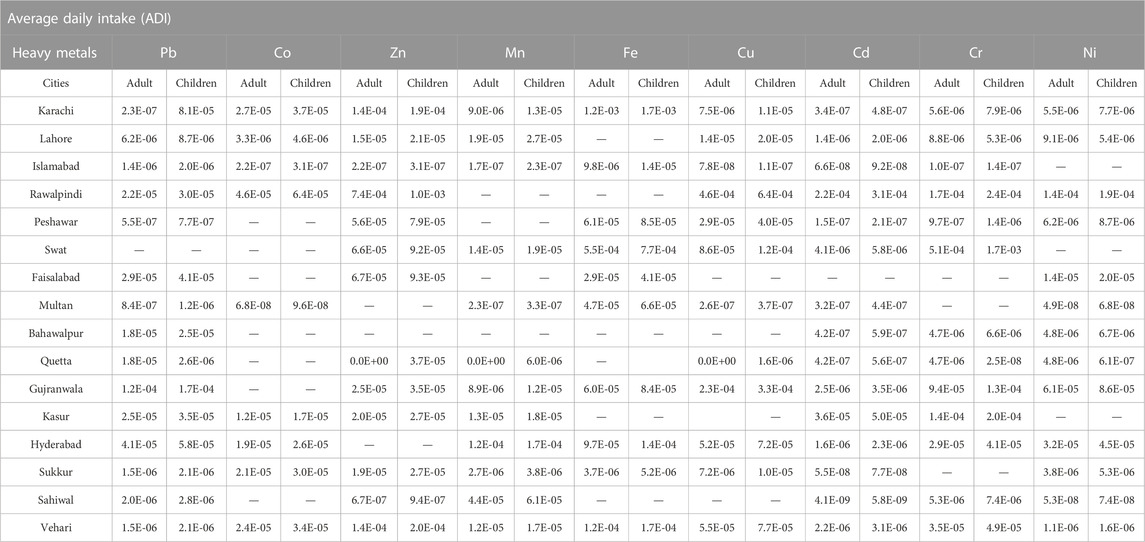
TABLE 4. Non-carcinogenic risk assessment based on average daily intake (ADI) in adults and children.
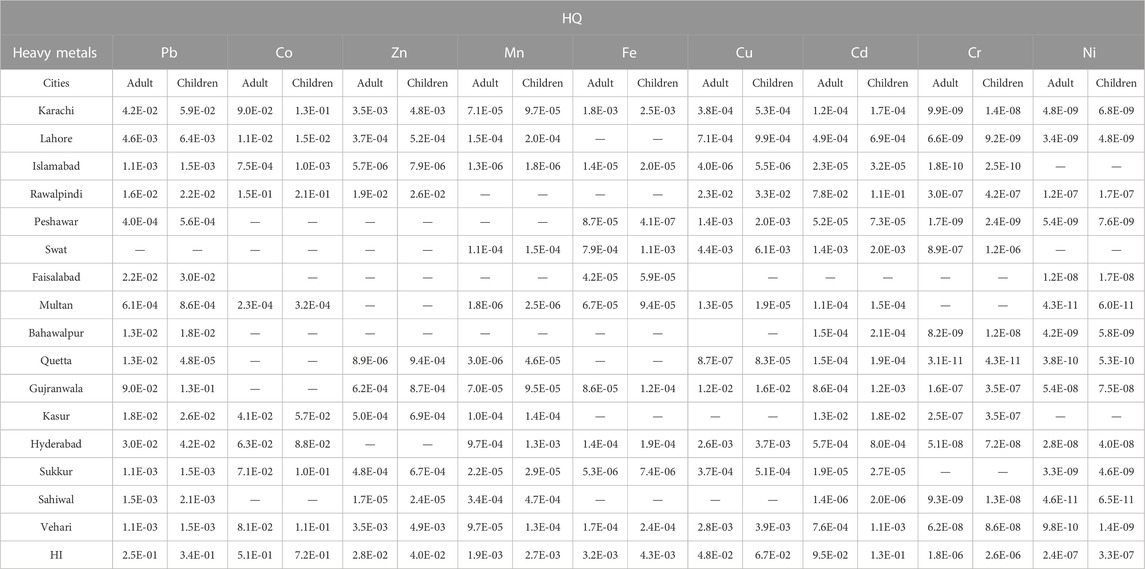
TABLE 5. Non-carcinogenic risk assessment via hazard quotient (HQ) and hazard index (HI) for adults and children.
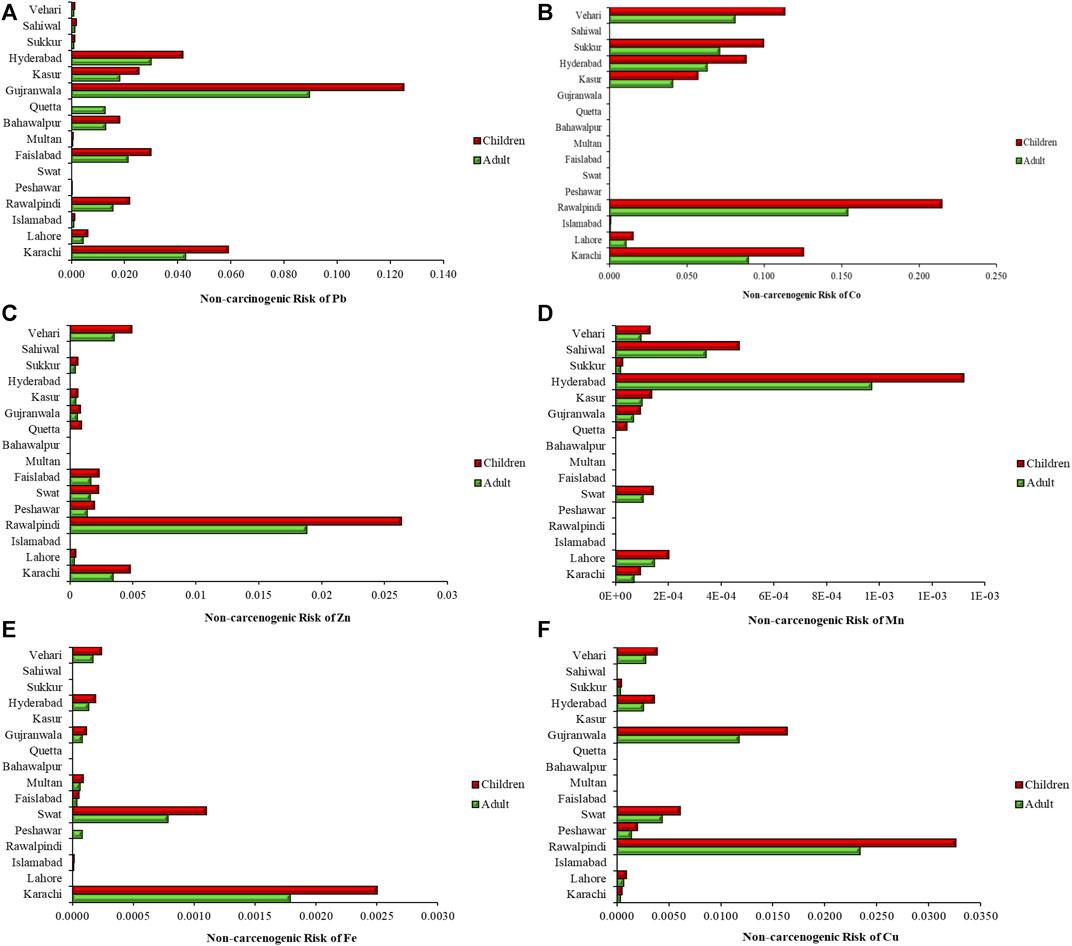
FIGURE 4. Non-carcinogenic risk assessment for Pb (A), Co (B), Zn (C), Mn (D), Fe (E), and Cu (F) in urban soils of selected cities of Pakistan using mean parameter values for HQ evaluation.
3.3.2 Carcinogenic risk assessment
Evaluating the carcinogenic risks to human health is a crucial undertaking focused on comprehending and addressing the possible dangers presented by heavy metals capable of inducing cancer. This study involves a meticulous evaluation of heavy metals (Cd, Cr and Ni) exposure pathways to determine the likelihood and magnitude of cancer development due to exposure of these heavy metals. Figure 5A illustrates the varying degrees of risk posed by Cadmium in the urban topsoil of major cities in Pakistan. The data in Table 3 provides insights into the levels of Cadmium-related risk in different Pakistani cities. The results unmistakably indicate that, among all the cities, Rawalpindi exhibits the highest risk levels, with a Cadmium value of 0.078 in adults and 0.109 in children. This phenomenon can be attributed primarily to rapid urbanization and the establishment of numerous projects and factories within the city limits. The concentration of traffic congestion and high-density housing projects within a limited radius has significantly impacted the city’s topsoil quality, consequently affecting the health of its residents, both adults and children. Notably, Swat exhibited the highest recorded value, with 9 × 10−7 for adults and 6 × 10−6 for children. Conversely, Lahore displayed the lowest values, measuring 7 × 10−9 for adults and 9 × 10−9 for children as shown in Figure 5B. The provided figure presents the outcomes concerning the exposure risk linked to the carcinogenic agent Cr across different cities within Pakistan. Despite the minimal level of risk and concentration of Cr in urban soil, the inherent carcinogenic nature of this agent underscores its potentially lethal effects. Of particular note, the highest level of risk was identified in Swat. These findings reflect the historical state of risk from Chromium in the topsoil of these cities. Depicted in Figure 5C are the levels of risk attributed to Nickel (Ni) in the urban topsoil of major cities in Pakistan. The results illustrate that Nickel is present in minute quantities in the considered cities. Specifically, Rawalpindi registered the highest value, measuring 1 × 10−07for adults and 2 × 10−07for children. In contrast, Vehari displayed lower values of 1 × 10−09 for adults and children. It is worth noting that despite the minimal presence of Nickel, the fact that it is a carcinogenic agent underscores the potential danger associated with continuous and prolonged exposure, both to the environment and humans. These findings reflect the historical state of risk from Nickel in the topsoil of these cities.
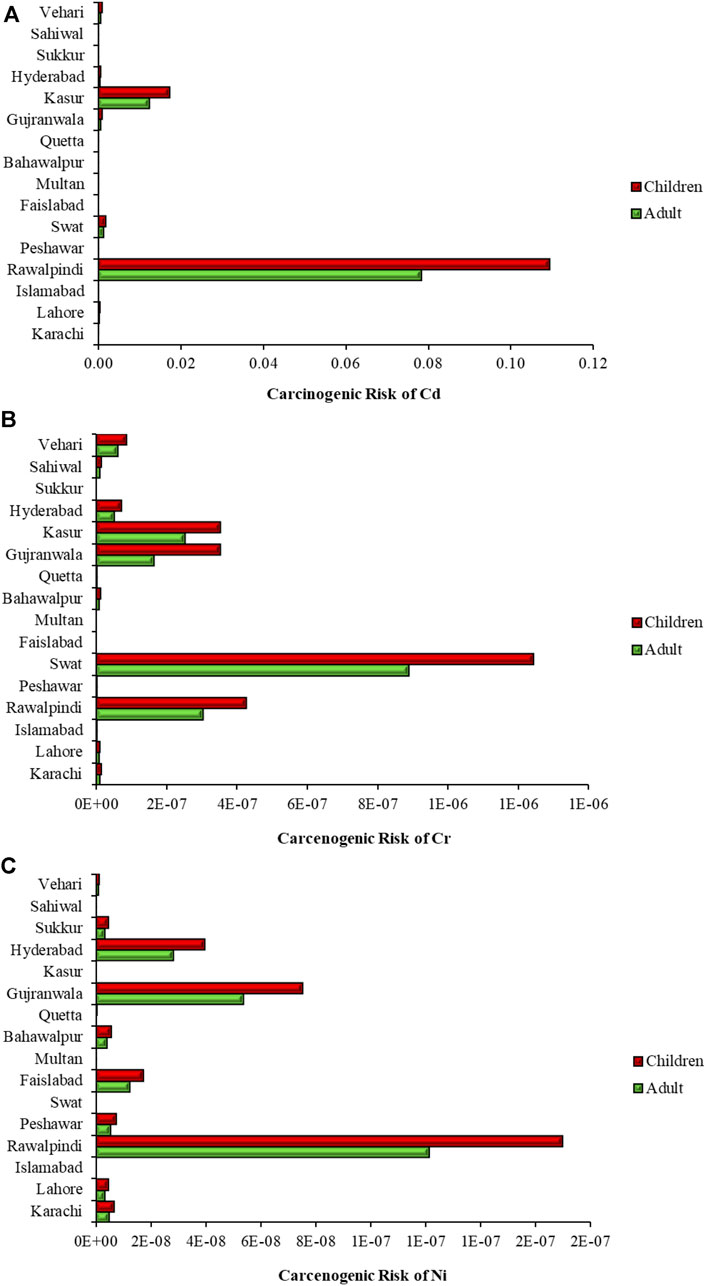
FIGURE 5. Carcinogenic risk assessment for Cd (A), Cr (B), and Ni (C) in urban soils of selected cities of Pakistan using mean parameter values for CR estimation.
4 Discussion
Rawalpindi city exhibited the highest cadmium concentration among selected cities in Pakistan, reaching 164 mg/kg, while the average concentration across cities was 13.35 mg/kg, surpassing both the WHO Standard (0.8 mg/kg) and PAK-EPA standards (3 mg/kg). Despite the WHO soil quality standard aiming to protect humans, plants, and animals by considering multiple exposure pathways, about 50% of the studied soils in Pakistani cities exceeded the WHO target value for cadmium, raising concerns for potential risks to ecosystems. Various sources contribute to increased cadmium levels in soils, including industrial activities, metal processing, atmospheric emissions, and the prevalence of cadmium-plated items. Natural sources, like volcanic activity and rock weathering, along with human activities such as mining, introduce cadmium into the environment. This persistent element can be transported by air and water as nanoparticles. Elevated cadmium concentrations in the atmosphere can compromise lung health. Prolonged exposure, especially through sources like air, food, water, and cigarette smoke, can lead to cadmium accumulation in the kidneys, resulting in renal and bone diseases, gastrointestinal irritation, and respiratory problems. The carcinogenic properties of cadmium further amplify health concerns, contributing to bone demineralization, cardiovascular effects, osteoporosis, and lung damage (Tahir and Yasmin, 2019).
Gujranwala, with a soil lead concentration reaching 89.0 mg/kg, exhibited the highest levels among the cities studied. The heightened Pb concentration in Gujranwala is attributed to factors such as industrial operations, traffic emissions, improper waste disposal, agricultural practices, and potentially natural geological processes that release lead into the environment. Despite this, the mean Pb concentration of 16.08 mg/kg in the study falls below the WHO and PAK-EPA soil quality standard of 85 mg/kg, indicating a relatively lower level of lead contamination. Comparisons with studies in Bangladesh and other countries show variability in lead concentrations. If soils in Pakistani cities surpass the WHO’s target value for lead, there are concerns about potential health risks, including anemia, paralysis, renal problems, and brain damage. Severe consequences, especially during pregnancy, involve neurological damage, developmental disorders, cognitive impairments, reduced IQ, behavioral problems, and kidney damage associated with high lead exposure (Bostan et al., 2009).
Rawalpindi, among the studied cities, exhibits the highest cobalt concentration at 33.37 mg/kg, while the overall average across selected cities in Pakistan is 12.36 mg/kg. Despite the essential role of cobalt, particularly as a component of the vitamin B12 complex, cobalt mining poses environmental concerns, contributing to pollution and impacting eutrophication and global warming through activities like blasting and electricity consumption. This mining process generates significant amounts of carbon dioxide and nitrogen dioxide, highlighting the need for addressing these environmental effects. While the average cobalt concentration remains well below the WHO and PAK-EPA standards of 50 mg/kg, it is crucial to monitor and manage cobalt levels. Excessive oral intake of cobalt can result in adverse effects on humans, terrestrial and aquatic ecosystems, plants, and animals. Toxic effects include increased red blood cell counts (polycythemia), cardiomyopathy, and adverse impacts on the male reproductive system. Exposure to cobalt is also associated with discomfort in the skin, eyes, nose, and throat, along with respiratory problems and potential effects on the heart and thyroid. Future exposure may lead to symptoms such as chest tightness, wheezing, coughing, and shortness of breath, with various organs like the thyroid, liver, kidneys, and heart being susceptible to cobalt-related harm.
Rawalpindi, among the selected Pakistani cities, exhibits the highest zinc concentration at 543 mg/kg, with an average concentration of 73.79 mg/kg across cities. This average exceeds the globally recognized thresholds set by the WHO and PAK-EPA, advocating for a maximum of 50 mg/kg. Previous research by Milam et al. (2017) indicated a broader range of zinc concentrations in soil samples, surpassing the values found in this investigation. Fosu-Mensah et al. (2017) observed similarities in iron (Fe) levels, while Awokunmi et al. (2010) documented considerably higher zinc levels in soil samples, diverging significantly from the present study’s results. Soil containing zinc concentrations between 70 and 400 mg/kg is considered highly toxic for plant growth. Despite zinc’s recognized benefits for health, such as mitigating inflammation and supporting immunological wellbeing, excessive exposure can lead to gastrointestinal disturbances. It is crucial to note that fatal doses of zinc range from 10 to 30 g, emphasizing the need for moderation. Topical zinc application is generally safe, but on wounded skin, it may provoke sensations of burning, stinging, itching, and tingling. The substantial presence of zinc in soils, not necessarily in toxic waste sites, has the potential to contaminate groundwater. Additionally, industries releasing dust with elevated zinc concentrations into the atmosphere can contribute to soil and waterway contamination.
Hyderabad, among the selected cities in Pakistan, records the highest manganese concentration at 90 mg/kg, while the average across cities is 15.2 mg/kg. Despite the essential role of manganese in various metabolic processes, including the metabolism of amino acids, cholesterol, glucose, and carbohydrates, the average concentration remains comfortably below the globally recognized standards of 100 mg/kg set by the WHO and PAK-EPA. The WHO’s comprehensive soil quality guideline, considering various exposure pathways, ensures that manganese levels in the selected Pakistani cities are within acceptable limits, safeguarding human health. Manganese also contributes to vital functions such as bone development, blood coagulation, and inflammation regulation. However, it is important to note that excessive exposure to high levels of manganese has been linked to neurological symptoms resembling those seen in Parkinson’s disease. Additionally, plants exhibit distinct responses to manganese in both toxic and insufficient conditions, with insufficiency more frequent in soils with lower pH levels.
Karachi records the highest iron concentration among selected cities in Pakistan, reaching 908 mg/kg, while the average concentration across cities is 177.70 mg/kg. Despite the essential role of iron in the body’s growth and development processes, the average falls well below the WHO and PAK-EPA standard of 50,000 mg/kg. The WHO’s comprehensive soil quality standard, considering diverse exposure pathways, ensures that iron levels in the selected Pakistani cities remain uncontaminated. The elevated iron concentration in Karachi is attributed to inadequate sanitary and sewage systems, along with limited access to clean drinking water, exacerbated by the city’s high level of urbanization. Natural sources of iron in soils, as highlighted by studies like Eddy et al. (2006), contribute substantially to environmental iron concentrations, not solely waste materials. Iron is crucial for proteins like myoglobin and hemoglobin, facilitating oxygen distribution in the body. Excessive iron exposure, while necessary to some extent, can lead to organ damage. The importance of removing excess iron is emphasized in curbing contaminant proliferation in the environment, especially since various pollutants, including uranium, can bond with iron and influence their distribution.
Rawalpindi’s soil exhibits an elevated copper concentration, ranging from 0.06 to 336.0 mg/kg, possibly attributed to unregulated industrial emissions and waste incineration activities observed by Kormoker et al. (2021). The collective mean copper concentration across all studied cities is 54.88 mg/kg, surpassing WHO and PAK-EPA standards of 36 mg/kg, indicating considerable copper contamination in major city soils. Hasnine et al. (2017) reported an average copper concentration of 91.06 ± 152.70 mg/kg in surface agricultural soil at DEPZA. Elevated copper concentrations can have detrimental effects on plants, especially when enriched liquid dairy waste is used for irrigation in agricultural lands. This study underscores the potential threat posed by copper to plants, emphasizing its toxicity to specific microorganisms, as highlighted by Hasnine et al. (2017). Copper, while essential for the human body in aiding red blood cell production and contributing to overall health, can lead to gastrointestinal discomfort and copper buildup in the liver and brain in instances of Wilson’s disease. The negative impact of copper extends to soil microorganisms and insects, causing disruptions in organic material decomposition, and may pose risks to livestock ingesting hazardous copper levels in agricultural fields tainted with copper.
Swat city in Pakistan registers the highest average chromium concentration at 863.8 mg/kg in this study, potentially attributed to industrial activities like metal processing and leather tanning. The sources of elevated chromium levels in Swat city include tanneries releasing chromium-laden waste into water bodies and soil, along with mining activities such as chromite extraction (Saddique et al., 2018). The average chromium concentration across all selected cities is 131.23 mg/kg, surpassing both the WHO Soil Quality Standard and PAK EPA threshold of 100 mg/kg. This exceeds levels reported in other investigations conducted across different countries. Chromium, released into agricultural areas adjacent to industrial zones, leads to soil contamination, impacting plant growth and essential metabolic processes (Hasnine et al., 2017). Exposure to chromium through crops has been linked to an increased incidence of skin allergies and respiratory issues (Shakir et al., 2017). Studies highlight chromium’s toxic threat, affecting seed quality, yield, and the quality of vegetables and wheat. Therefore, a comprehensive monitoring approach is deemed necessary for water, soil, and agricultural production systems (Sharma et al., 2020).
Rawalpindi, in this study, exhibits the highest nickel concentration at 236.0 mg/kg, attributed to various factors, including industrial operations like metal processing and electroplating, traffic-related pollution, inappropriate waste disposal, and natural geological conditions. The wide range of nickel concentrations throughout the research, from 0.08 mg/kg in Multan to the peak in Rawalpindi, underscores the impact of these variables. The average nickel concentration across the investigated cities is 35.47 mg/kg, slightly exceeding both WHO and PAK-EPA standards recommending a maximum nickel concentration of 35 mg/kg in soil. This surpasses levels reported in similar research conducted in Bangladesh and several other countries. Human exposure to nickel, associated with health issues such as dermatitis, lung fibrosis, cardiovascular and kidney diseases, and respiratory tract cancer, emphasizes the health risks posed by elevated nickel levels. Nickel, entering the body through various pathways, including skin contact, ingestion, and inhalation, can result in harmful health effects with prolonged or severe exposure, as noted by Genchi et al. (2020) and sensitization of the skin, triggering respiratory ailments (Shakir et al., 2017). Additionally, nickel’s environmental impact extends to greenhouse gas emissions, biodiversity loss, and pollution of air, water, and soil, given its prevalence in low-grade ores, necessitating resource-intensive extraction and refining processes (Shahzad et al., 2018). A comparative analysis of among selected heavy metal concentrations in soil, as presented in Table 6.
5 Conclusion
The research undertook a thorough examination of enrichment factors, geo-accumulation indices, and human health risk assessments concerning the presence of heavy metals in urban soils across diverse cities in Pakistan. The geo accumulation index outcomes revealed a spectrum of risk levels, spanning from “no pollution” for Pb, Co, Mn, and Fe to “moderate to extremely contaminated” for Cd, Zn, Cr, Ni, and Cu. Employing EF analysis, we found that the heavy metal presence in the study area was considerable concern, with risk levels varying from “moderate to extremely strong pollution” for Cd, Zn, Cr, Ni, and Cu, to “no pollution” for Pb, Co, Mn, and Fe. When evaluating health risks, both non-carcinogenic and carcinogenic risks were notably present for both children and adults. Various contributors, including industries, vehicular emissions, urbanization, and agricultural activities, were identified as substantial factors contributing to the heightened levels of heavy metals in the analyzed urban soil environments. It became evident that urban industrial zones within these metropolises are intricately linked to both human health and long-term economic viability. The findings from this study can be immensely valuable for decision-makers seeking to formulate more effective strategies to reduce exposure and efficiently manage soil pollution.
Data availability statement
The original contributions presented in the study are included in the article/Supplementary Material, further inquiries can be directed to the corresponding authors.
Author contributions
HA: Writing–original draft. RN: Writing–original draft. IN: Writing–review and editing. MI: Writing–review and editing. AI: Writing–original draft. IK: Writing–original draft. MO: Writing–review and editing. GW: Writing–review and editing. ZA: Writing–review and editing. MB: Writing–review and editing.
Funding
The authors declare that no financial support was received for the research, authorship, and/or publication of this article.
Acknowledgments
The authors extend their appreciation to the Researchers Supporting Project number (RSP2023R374) King Saud University, Riyadh, Saud Arabia.
Conflict of interest
The authors declare that the research was conducted in the absence of any commercial or financial relationships that could be construed as a potential conflict of interest.
Publisher’s note
All claims expressed in this article are solely those of the authors and do not necessarily represent those of their affiliated organizations, or those of the publisher, the editors and the reviewers. Any product that may be evaluated in this article, or claim that may be made by its manufacturer, is not guaranteed or endorsed by the publisher.
Supplementary material
The Supplementary Material for this article can be found online at: https://www.frontiersin.org/articles/10.3389/fenvs.2023.1260317/full#supplementary-material
References
Adimalla, N. (2020). Heavy metals pollution assessment and its associated human health risk evaluation of urban soils from Indian cities: a review. Env. geochem health. 42, 173–190. doi:10.1007/s10653-019-00324-4
Afzal, M., Shabir, G., Iqbal, S., Mustafa, T., Khan, Q. M., and Khalid, Z. M. (2014). Assessment of heavy metal contamination in soil and groundwater at leather industrial area of Kasur, Pakistan. Air, Water 42, 1133–1139. doi:10.1002/clen.201100715
Almasoud, F. I., Usman, A. R., and Al-Farraj, A. S. (2015). Heavy metals in the soils of the Arabian Gulf coast affected by industrial activities: analysis and assessment using enrichment factor and multivariate analysis. Arab. J. Geosci. 8, 1691–1703. doi:10.1007/s12517-014-1298-x
Awokunmi, E. E., Asaolu, S. S., and Ipinmoroti, K. O. (2010). Effect of leaching on heavy metals concentration of soil in some dumpsites. Afr. J. Environ. Sci. Technol. 4 (8), 495–499.
Bostan, N., Ashraf, M., Mumtaz, A. S., and Ahmad, I. (2007). Diagnosis of heavy metal contamination in agro-ecology of Gujranwala, Pakistan using cattle egret (Bubulcus ibis) as bioindicator. Ecotoxicology 16, 247–251. doi:10.1007/s10646-006-0124-y
Bux, R. K., Haider, S. I., Batool, M., Solangi, A. R., Shah, Z., Karimi-Maleh, H., et al. (2021). Assessment of heavy metal contamination and its sources in urban soils of district Hyderabad, Pakistan using GIS and multivariate analysis. IJEST 3, 7901–7913. doi:10.1007/s13762-021-03691-7
Chakraborty, T. K., Islam, M. S., Ghosh, G. C., Ghosh, P., Zaman, S., Hossain, M. R., et al. (2023). Receptor model-based sources and risks appraisal of potentially toxic elements in the urban soils of Bangladesh. Toxicol. Rep. 10, 308–319. doi:10.1016/j.toxrep.2023.02.011
Das, D., Hasan, M., and Howladar, M. F. (2023). Topsoil heavy metals status and potential risk assessment around the cement factories in Chhatak, Bangladesh. Environ. Dev. Sustain. 25 (6), 5337–5362. doi:10.1007/s10668-022-02269-8
Dong, B., Zhang, R., Gan, Y., Cai, L., Freidenreich, A., Wang, K., et al. (2019). Multiple methods for the identification of heavy metal sources in cropland soils from a resource-based region. Sci. Total Environ. 651, 3127–3138. doi:10.1016/j.scitotenv.2018.10.130
Eddy, N. O., Odoemelem, S. A., and Mbaba, A. (2006). Elemental composition of soil in some dumpsites. EJEAFChe 5 (3), 1349–1363.
Ehsan, N., Nawaz, R., Ahmad, S., Arshad, M., Hayyat, M. U., and Mahmood, R. (2016a). Remediation of lead-contaminated soil by ornamental plant “Vinca” (Vinca rosea L.). J. Biodivers. Env. Sci. 8, 46–54.
Ehsan, N., Nawaz, R., Ahmad, S., Arshad, M., Sarmad, M., and Umair, M. (2016b). Remediation of heavy metal-contaminated soil by ornamental plant zinnia (zinnia elegance L.). J. Chem. 28, 1338–1342. doi:10.14233/ajchem.2016.19701
Ehsan, N., Nawaz, R., Ahmad, S., Khan, M. M., and Hayat, J. (2016c). Remediation of chromium-contaminated soil by an ornamental plant, Vinca (Vinca rosea L.). J. Env Agri. Sci. 7, 29–34.
Figueiredo, A. M. G., Tocchini, M., and dos Santos, T. F. S. (2011). Metals in playground soils of Sao Paulo city, Brazil. Procedia Environ. Sci. 4, 303–309. doi:10.1016/j.proenv.2011.03.035
Fosu-Mensah, B. Y., Addae, E., Yirenya-Tawiah, D., and Nyame, F. (2017). Heavy metals concentration and distribution in soils and vegetation at Korle Lagoon area in Accra, Ghana. Cogent Environ. Sci. 3 (1), 1405887. doi:10.1080/23311843.2017.1405887
Genchi, G., Carocci, A., Lauria, G., and SinicropiCatalano, M. S. A. (2020). Nickel: human health and environmental toxicology. Int. J. Environ. Res. Public Health 17, 679. doi:10.3390/ijerph17030679
Grzetic, I., and Ghariani, R. H. A. (2008). Potential health risk assessment for soil heavy metal contamination in the central zone of Belgrade (Serbia). J. Serb Chem. Soc. 73, 923–934. doi:10.2298/jsc0809923g
Hasnine, M. T., Huda, M. E., Khatun, R., Saadat, A. H. M., Ahasan, M., Akter, S., et al. (2017). Heavy metal contamination in agricultural soil at DEPZA, Bangladesh. Environ. Ecol. Res. 5 (7), 510–516. doi:10.13189/eer.2017.050707
Hayyat, M. U., Nawaz, R., Siddiq, Z., Shakoor, M. B., Mushtaq, M., Ahmad, S. R., et al. (2021). Investigation of lithium application and effect of organic matter on soil health. Sustainability 13, 1705–1715. doi:10.3390/su13041705
Huang, S., Wang, L., and Zhao, Y. (2018). Ecological risk assessment from the perspective of soil heavy metal accumulations in Xiamen city, China. Int. J. Sustain. Dev. World Ecol. 25, 411–419. doi:10.1080/13504509.2017.1418457
Iqbal, H. H., Taseer, R., Anwar, S., Mumtaz, M., Qadir, A., and Shahid, N. (2016). Human health risk assessment: heavy metal contamination of vegetables in Bahawalpur, Pakistan. Bull. Environ. Stud. 1 (1), 10.
Jiang, X., Zou, B., Feng, H., Tang, J., Tu, Y., and Zhao, X. (2019). Spatial distribution mapping of Hg contamination in subclass agricultural soils using GIS enhanced multiple linear regression. J. Geochem. Explor. 196, 1–7. doi:10.1016/j.gexplo.2018.10.002
Kabir, M. H., Kormoker, T., Shammi, R. S., Tusher, T. R., Islam, M. S., Khan, R., et al. (2022). A comprehensive assessment of heavy metal contamination in road dusts along a hectic national highway of Bangladesh: spatial distribution, sources of contamination, ecological and human health risks. Toxin Rev. 41 (3), 860–879. doi:10.1080/15569543.2021.1952436
Kakar, R. G., Masoom, Y., and Salarzai, A. U. (2005). Studies on the heavy metals pollution of soil in Quetta sewage water irrigated area.
Karim, Z., and Qureshi, B. A. (2014). Health risk assessment of heavy metals in urban soil of Karachi, Pakistan. HERA 20 (3), 658–667. doi:10.1080/10807039.2013.791535
Keshav Krishna, A., and Rama Mohan, K. (2016). Distribution, correlation, ecological and health risk assessment of heavy metal contamination in surface soils around an industrial area, Hyderabad, India. Environ. Earth Sci. 75, 411. doi:10.1007/s12665-015-5151-7
Khan, M. N., Wasim, A. A., Sarwar, A., and Rasheed, M. F. (2011). Assessment of heavy metal toxicants in the roadside soil along the N-5, National Highway, Pakistan. Environ. Monit. Assess. 182, 587–595. doi:10.1007/s10661-011-1899-8
Kormoker, T., Proshad, R., Islam, S., Ahmed, S., Chandra, K., Uddin, M., et al. (2021). Toxic metals in agricultural soils near the industrial areas of Bangladesh: ecological and human health risk assessment. Toxin Rev. 40 (4), 1135–1154. doi:10.1080/15569543.2019.1650777
Kumar, V., Bhatti, R. C., Kaur, R., Singh, S., Nirmala, C., and Singh, A. N. (2023). Comparative geo-accumulation index of heavy metal concentration in the urban soils of chandigarh and baddi areas under industrial activities in A lower shiwalik region. India. Eur. Chem. Bull. 12, 937–953. doi:10.48047/ecb/2023.12.si10.00110
Liu, L., Li, W., Song, W., and Guo, M. (2018). Remediation techniques for heavy metal-contaminated soils: principles and applicability. Sci. Total Environ. 633, 206–219. doi:10.1016/j.scitotenv.2018.03.161
Liu, L., Liu, Q., Ma, J., Wu, H., Qu, Y., Gong, Y., et al. (2020). Heavy metal (loid) s in the topsoil of urban parks in Beijing, China: concentrations, potential sources, and risk assessment. Environ. Pollut. 260, 114083. doi:10.1016/j.envpol.2020.114083
Luo, X. S., Ding, J., Xu, B., Wang, Y. J., Li, H. B., and Yu, S. (2012). Incorporating bioaccessibility into human health risk assessments of heavy metals in urban park soils. Sci. Total Environ. 424, 88–96. doi:10.1016/j.scitotenv.2012.02.053
Mahmood, A., and Malik, R. N. (2014). Human health risk assessment of heavy metals via consumption of contaminated vegetables collected from different irrigation sources in Lahore, Pakistan. Arab. J. Chem. 7 (1), 91–99. doi:10.1016/j.arabjc.2013.07.002
Muller, G. M. M. (1969). Index of geoaccumulation in sediments of the rhine river. Geojournal 2, 108–118.
Nawaz, R., Aslam, M., Nasim, I., Irshad, M. A., Ahmad, S., Latif, M., et al. (2023a). Air pollution tolerance index and heavy metals accumulation of tree species for sustainable environmental management in megacity of Lahore. Air 1, 55–68. doi:10.3390/air1010004
Nawaz, R., Nasim, I., Irfan, A., Islam, A., Naeem, A., Ghani, N., et al. (2023b). Water quality index and human health risk assessment of drinking water in selected urban areas of a mega city. Toxics 11 (7), 577. doi:10.3390/toxics11070577
Parveen, N., Ghaffar, A., Shirazi, S. A., and Bhalli, M. N. (2015). A GIS based assessment of heavy metals contamination in surface soil of urban parks: a case study of Faisalabad City-Pakistan. J. Geogr. Nat. Disasters 2, 12–18. doi:10.4172/2167-0587.1000105
Rafique, U., Kaukab, H., and Iqbal, S. (2011). Quantitative speciation of heavy metals in soil and crops of agricultural fields of Islamabad, Pakistan. Pak. Chem. Speciat. Bioavailab. 23 (2), 110–117. doi:10.3184/095422911x13031473567331
Randhawa, M. A., Ahmad, G., Anjum, F. M., Asghar, A., and Sajid, M. W. (2014). Heavy metal contents and their daily intake in vegetables under peri-urban farming system of Multan, Pakistan. Pak. J. Agric. Sci. 51, 20–28.
Rasheed, H., Jaleel, F., and Nisar, M. F. (2014). Analyzing the status of heavy metals in irrigation water in suburban areas of Bahawalpur city, Pakistan. AEJAES 14, 732–738. doi:10.5829/idosi.aejaes.2014.14.08.12380
Rashid, A., Schutte, B. J., Ulery, A., Deyholos, M. K., Sanogo, S., Lehnhoff, E. A., et al. (2023). Heavy metal contamination in agricultural soil: environmental pollutants affecting crop health. Agronomy 13, 1521. doi:10.3390/agronomy13061521
Rezapour, S., Siavash Moghaddam, S., Nouri, A., and Khosravi Aqdam, K. (2022). Urbanization influences the distribution, enrichment, and ecological health risk of heavy metals in croplands. Sci. Rep. 12, 3868. doi:10.1038/s41598-022-07789-x
Saddique, U., Muhammad, S., Tariq, M., Zhang, H., Arif, M., Jadoon, I. A., et al. (2018). Potentially toxic elements in soil of the Khyber Pakhtunkhwa province and Tribal areas, Pakistan: evaluation for human and ecological risk assessment. Environ. Geochem. health 40, 2177–2190. doi:10.1007/s10653-018-0091-2
Sarwar, T., Shahid, M., Khalid, S., Shah, A. H., Ahmad, N., Naeem, M. A., et al. (2020). Quantification and risk assessment of heavy metal build-up in soil–plant system after irrigation with untreated city wastewater in Vehari, Pakistan. Environ. Geochem. health 42, 4281–4297. doi:10.1007/s10653-019-00358-8
Shahzad, B., Tanveer, M., Rehman, A., Cheema, S. A., Fahad, S., Rehman, S., et al. (2018). Nickel; whether toxic or essential for plants and environment-A review. Plant Physiology Biochem. 132, 641–651. doi:10.1016/j.plaphy.2018.10.014
Shakir, S. K., Azizullah, A., Murad, W., Daud, M. K., Nabeela, F., Rahman, H., et al. (2017). Toxic metal pollution in Pakistan and its possible risks to public health. Rev. Environ. Contam. Toxicol. 242, 1–60. doi:10.1007/398_2016_9
Sharma, A., Kapoor, D., Wang, J., Shahzad, B., Kumar, V., BaliYan, A. S. D., et al. (2020). Chromium bioaccumulation and its impacts on plants: an overview. Plants 9, 100. doi:10.3390/plants9010100
Solgi, E., Esmaili-Sari, A., Riyahi-Bakhtiari, A., and Hadipour, M. (2012). Soil contamination of metals in the three industrial estates, Arak, Iran. Bull. Environ. Contam. Toxicol. 88, 634–638. doi:10.1007/s00128-012-0553-7
Sun, L., Guo, D., Liu, K., Meng, H., Zheng, Y., Yuan, F., et al. (2019). Levels, sources, and spatial distribution of heavy metals in soils from a typical coal industrial city of Tangshan, China. CATENA 175, 101–109. doi:10.1016/j.catena.2018.12.014
Sutherland, R. A. (2000). Bed sediment-associated trace metals in an urban stream, Oahu, Hawaii. Environ. Geol. 39, 611–627. doi:10.1007/s002540050473
Tahir, U., and Yasmin, A. (2019). Role of bacterial extracellular polymeric substances (EPS) in uptake and accumulation of co-contaminants. IJEST 16 (12), 8081–8092. doi:10.1007/s13762-019-02360-0
Tong, S., Li, H., Wang, L., Tudi, M., and Yang, L. (2020). Concentration, spatial distribution, contamination degree and human health risk assessment of heavy metals in urban soils across China between 2003 and 2019—a systematic review. IJERPH 17, 3099. doi:10.3390/ijerph17093099
Tudi, M., Li, H., Li, H., Wang, L., Lyu, J., Yang, L., et al. (2022). Exposure routes and health risks associated with pesticide application. Toxics 10 (6), 335. doi:10.3390/toxics10060335
Ur Rehman, K., Bukhari, S. M., Andleeb, S., Mahmood, A., Erinle, K. O., Naeem, M. M., et al. (2019). Ecological risk assessment of heavy metals in vegetables irrigated with groundwater and wastewater: the particular case of Sahiwal district in Pakistan. Agric. Water Manag. 226, 105816. doi:10.1016/j.agwat.2019.105816
USEPA (2002). Supplemental guidance for developing soil screening levels for superfund sites, OSWER 9355. 4-24. Washington, DC, USA: Office of Emergency and Remedial Response.
USEPA (2011). Regional screening level table (RSL). Regional screening levels of chemical contaminants at superfund sites. Available at http://www.epa.gov/reg3hwmd/risk/human/rb-concentrationtable/index.htm.
USEPA (US Environmental Protection Agency) (1989). Risk assessment guidance for superfund. Volume I: human health evaluation manual (Part A). EPA/540/1-89/002. Washington, DC, USA: Office of Emergency and Remedial Response.
Wang, Z., Chai, L., Yang, Z., Wang, Y., and Wang, H. (2010). Identifying sources and assessing potential risk of heavy metals in soils from direct exposure to children in a mine-impacted city, Changsha, China. J. Environ. Qual. 39, 1616–1623. doi:10.2134/jeq2010.0007
Xiao, R., Guo, D., Ali, A., Mi, S., Liu, T., Ren, C., et al. (2019). Accumulation, ecological−health risks assessment, and source apportionment of heavy metals in paddy soils: a case study in Hanzhong, Shaanxi, China. Environ. Pollut. 248, 349–357. doi:10.1016/j.envpol.2019.02.045
Yang, Q., Zhang, L., Wang, H., and Martín, J. D. (2022). Bioavailability and health risk of toxic heavy metals (As, Hg, Pb and Cd) in urban soils: a Monte Carlo simulation approach. Environ. Res. 214, 113772. doi:10.1016/j.envres.2022.113772
Yuan, X., Xue, N., and Han, Z. (2021). A meta-analysis of heavy metals pollution in farmland and urban soils in China over the past 20 years. J. Environ. Sci. 101, 217–226. doi:10.1016/j.jes.2020.08.013
Zhang, J., Peng, W., Lin, M., Liu, C., Chen, S., Wang, X., et al. (2023). Environmental geochemical baseline determination and pollution assessment of heavy metals in farmland soil of typical coal-based cities: a case study of Suzhou City in Anhui Province, China. Heliyon 9 (4), e14841. doi:10.1016/j.heliyon.2023.e14841
Zhang, R., Chen, T., Zhang, Y., Hou, Y., and Chang, Q. (2020). Health risk assessment of heavy metals in agricultural soils and identification of main influencing factors in a typical industrial park in northwest China. Chemosphere 252, 126591. doi:10.1016/j.chemosphere.2020.126591
Zhang, Y., Li, S., Chen, Z., Wang, F., Chen, J., and Wang, L. (2018). A systemic ecological risk assessment based on spatial distribution and source apportionment in the abandoned lead acid battery plant zone, China. J. Hazard. Mater. 354, 170–179. doi:10.1016/j.jhazmat.2018.04.054
Zhao, K., Fu, W., Qiu, Q., Ye, Z., Li, Y., Tunney, H., et al. (2019). Spatial patterns of potentially hazardous metals in paddy soils in a typical electrical waste dismantling area and their pollution characteristics. Geoderma 337, 453–462. doi:10.1016/j.geoderma.2018.10.004
Zhou, L., Zhao, X., Meng, Y., Fei, Y., Teng, M., Song, F., et al. (2022). Identification priority source of soil heavy metals pollution based on source-specific ecological and human health risk analysis in a typical smelting and mining region of South China. Ecotoxicol. Environ. Saf. 242, 113864. doi:10.1016/j.ecoenv.2022.113864
Keywords: soil contamination, heavy metals, human health, risk assessment, carcinogenic
Citation: Ayaz H, Nawaz R, Nasim I, Irshad MA, Irfan A, Khurshid I, Okla MK, Wondmie GF, Ahmed Z and Bourhia M (2023) Comprehensive human health risk assessment of heavy metal contamination in urban soils: insights from selected metropolitan zones. Front. Environ. Sci. 11:1260317. doi: 10.3389/fenvs.2023.1260317
Received: 17 July 2023; Accepted: 29 November 2023;
Published: 13 December 2023.
Edited by:
Sarfuddin Azmi, Prince Sultan Military Medical City, Saudi ArabiaReviewed by:
Md. Saiful Islam, Patuakhali Science and Technology University, BangladeshMohd Kamil Hussain, Govt. Raza Post Graduate College, Rampur, India
Copyright © 2023 Ayaz, Nawaz, Nasim, Irshad, Irfan, Khurshid, Okla, Wondmie, Ahmed and Bourhia. This is an open-access article distributed under the terms of the Creative Commons Attribution License (CC BY). The use, distribution or reproduction in other forums is permitted, provided the original author(s) and the copyright owner(s) are credited and that the original publication in this journal is cited, in accordance with accepted academic practice. No use, distribution or reproduction is permitted which does not comply with these terms.
*Correspondence: Ali Irfan, cmFpYWxpaXJmYW5AZ21haWwuY29t; Rab Nawaz, cmFiLm5hd2F6QGVudnMudW9sLmVkdS5waw==; Mohammed Bourhia, Ym91cmhpYW1vaGFtbWVkQGdtYWlsLmNvbQ==
 Harris Ayaz
Harris Ayaz Rab Nawaz
Rab Nawaz Iqra Nasim
Iqra Nasim Muhammad Atif Irshad
Muhammad Atif Irshad Ali Irfan
Ali Irfan Iram Khurshid
Iram Khurshid Mohammad K. Okla
Mohammad K. Okla Gezahign Fentahun Wondmie
Gezahign Fentahun Wondmie Zulkifl Ahmed
Zulkifl Ahmed Mohammed Bourhia
Mohammed Bourhia